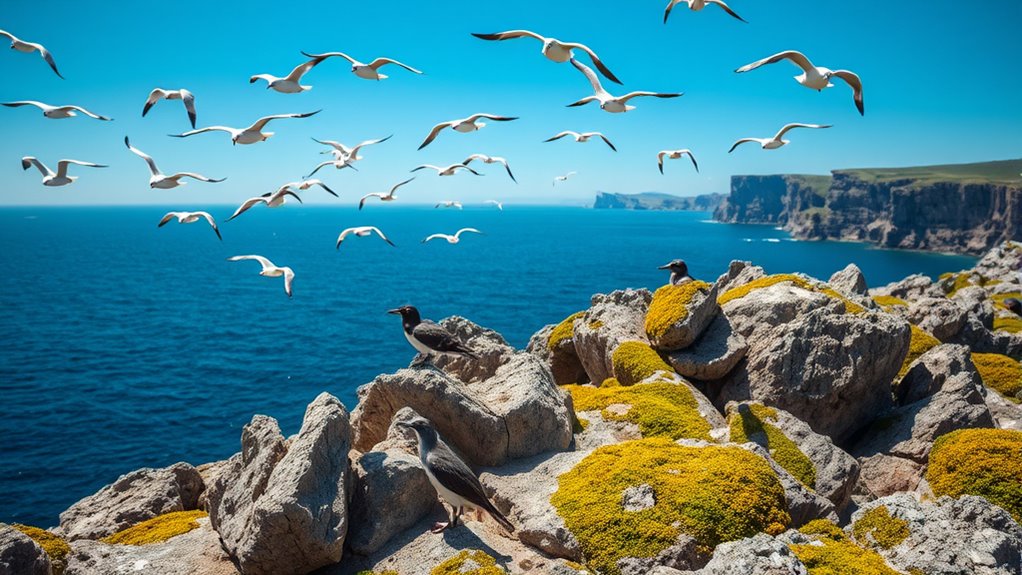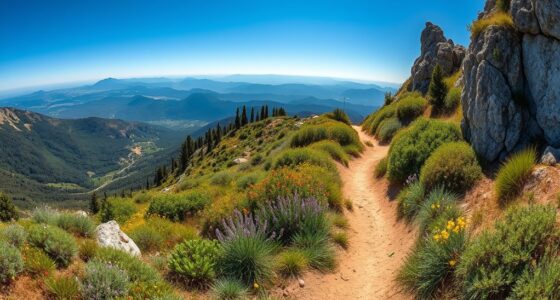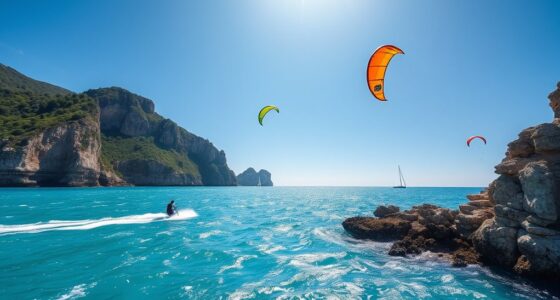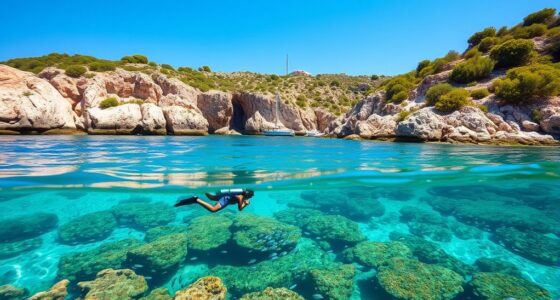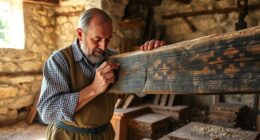Sardinia hosts important seabird species like Yelkouan and Scopoli’s Shearwaters, which nest on rocky islets and cliffs, and face threats from invasive predators and habitat loss. The island also serves as a key stopover for migrating birds, using wetlands and shrublands for rest and feeding. Conservation efforts focus on protecting breeding sites, monitoring populations, and reducing threats like pollution and illegal activities. Keep exploring to discover how ongoing actions aim to preserve Sardinia’s rich seabird diversity.
Key Takeaways
- Sardinia hosts important breeding colonies of seabirds like Scopoli’s Shearwaters and Mediterranean Gulls, mainly on rocky islands and cliffs.
- Key migratory stopover zones include wetlands and shrublands supporting species such as Glossy Ibis, Flamingos, and small passerines.
- Threats include invasive predators, habitat degradation, pollution, and illegal activities, impacting seabird populations and nesting sites.
- Marine habitats like Posidonia seagrass beds and rocky seabeds are vital for biodiversity, facing threats from fishing bycatch and pollution.
- Conservation efforts involve habitat protection, monitoring, reducing threats, and international collaboration to safeguard seabird populations.
Key Seabird Species Breeding on Sardinia

Sardinia hosts several important seabird species that breed in its diverse coastal and island habitats. One of the most notable is the Scopoli’s Shearwater, with around 10,000 breeding pairs in the Mediterranean. You’ll find large colonies on offshore islets and rocky archipelagos, such as Tremiti, which hosts about 400 pairs. These birds nest mainly in burrows or crevices on cliffs and rocky islands during spring and summer. Another key species is the Mediterranean gull, which breeds along the coast, often on secluded islands. The endemic Mediterranean Shag also breeds on Sardinia’s rocky coasts, forming small colonies. Protecting these sites is essential for maintaining healthy populations, especially given their importance for conservation within the Mediterranean region. Seabird habitats are critical for supporting breeding success and ensuring the survival of these species amid environmental threats.
Migratory Visitors and Rare Sightings

As you explore Sardinia, you’ll notice its essential role on migratory routes connecting Africa and Europe, making it a key stopover for many bird species. You might also come across rare sightings of African or Siberian migrants, highlighting the island’s unique position. Seasonal movements bring a variety of waterbirds and songbirds, offering exciting opportunities to observe transient and uncommon species. Many of these migrants utilize Sardinia’s habitats during their long journeys, underscoring the island’s importance for bird conservation. The presence of diverse habitats contributes significantly to the island’s status as a crucial bird habitat for migratory species.
Migratory Pathways Highlighted
The migratory pathways through the western Mediterranean are essential for seabirds traveling between Europe and Africa, with Sardinia acting as a key stopover point. You’ll notice major corridors crossing the Strait of Gibraltar and near Sardinian waters, connecting African and European coasts. During autumn, large flocks, including Scopoli’s shearwaters, use Sardinian wetlands and offshore islets to rest and refuel. GPS tracking shows that seabirds like Balearic shearwaters and Eleonora’s falcons follow specific routes influenced by sea currents, food sources, and geography. Coastal wetlands, small islands, and rocky coastlines serve as fundamental resting, breeding, and foraging sites. This migration highlights Sardinia’s strategic role in the Mediterranean seabird flyway, making it essential for conservation efforts and understanding seabird movement patterns. The island’s location makes Sardinia a crucial node in the migratory network, supporting diverse species during their long journeys.
Rare Species Encounters
Many rare bird species pass through Sardinia, turning the island into a hotspot for unusual sightings and migratory visitors. You might spot the Purple Gallinule or Glossy Ibis in wetlands, where they are more common than elsewhere in Europe. Spoonbills appear at sites like S’Ena Arrubia and Molentargius, while Little Bitterns, though elusive, frequent freshwater wetlands. The Great Egret is rare but seen near Holm Oak and Cork Oak forests. Squacco Herons breed locally, and species like Barbary Partridge and Little Bustard thrive in upland farms and open areas. Occasional migrants such as Alpine Swift and Crag Martin are spotted overhead, but some birds remain hard to document, requiring patience and knowledge of suitable habitats like wetlands, wetlands, and upland scrub.
Seasonal Bird Movements
Sardinia’s wetlands and coastal habitats serve as essential stopover points during the incredible journeys of migratory birds crossing the Mediterranean. You’ll notice that the island acts as a critical bridge between Europe and Africa along the Palaearctic-African flyway. Migrants from Central Africa, after crossing the Sahara and Mediterranean, depend on Sardinian wetlands like the Gulf of Oristano and Sinis Peninsula for rest and refueling. Arrival peaks occur in spring and autumn, with species like swallows, bee-eaters, and terns passing through. These wetlands support diverse guilds, especially waterbirds and insectivores, which rely on abundant food sources. Seasonal patterns vary, with some species arriving early or late. Protecting these habitats is essential for maintaining migration routes and supporting the many species that depend on Sardinia during their seasonal journeys. Many migratory birds use stars for navigation, a scientifically supported fact, further highlights the importance of preserving natural night skies in these areas. Additionally, safeguarding these habitats helps preserve migration corridors, which are vital pathways that facilitate successful seasonal movements.
Threats Facing Sardinian Seabirds

Seabirds around Sardinia face numerous threats that jeopardize their survival. Bycatch in fisheries, especially inshore gillnet fishing, causes high mortality rates, disrupting populations and reducing breeding success. Globally, around 400,000 seabirds die annually from accidental capture, and Sardinian species are particularly vulnerable near coastal fishing zones. Invasive predators like rats, gulls, and cats prey on eggs, chicks, and adults, while artificial lights disorient fledglings, increasing predation risks. Human activities such as coastal development and tourism disturb breeding sites, degrade habitats, and fragment colonies. Climate change alters prey distribution, forcing seabirds to expend more energy and suffer nutritional stress. Pollution, including oil spills and plastic debris, contaminates their environment, causes injuries, and leads to starvation. Proper waste management is essential to reduce pollution impacts. These combined threats threaten their long-term survival on Sardinia.
Conservation Areas and Protecting Habitats

You can see how Sardinia’s key breeding sites and migratory stopover zones are carefully safeguarded within marine and terrestrial reserves. These areas ensure seabirds have safe places to breed, rest, and refuel during their long journeys. By maintaining these habitats, we help secure the future of Sardinia’s seabird populations. These protected zones also promote ecological balance and provide vital habitats for numerous other species. Implementing conservation strategies in these areas further enhances the effectiveness of habitat protection efforts.
Key Breeding Sites
Major breeding sites for seabirds in Sardinia are concentrated along the northwestern coast and nearby islands, where the ecological conditions are essential for nesting. These sites include rocky coastlines, caves, and remote islets that offer safe habitats with minimal predators. The region hosts key species like Mediterranean Storm Petrels, Scopoli’s Shearwater, and Cory’s and Yelkouan Shearwaters on islands such as Linosa and the Egadi Islands. Many colonies are within protected areas, including marine reserves and the Pelagos Sanctuary, providing legal safeguards against disturbances. These habitats support chick rearing and adult foraging, benefiting from rich neritic zones and low light pollution. Despite protections, threats like invasive predators, illegal activities, and habitat fragmentation continue, demanding vigilant conservation efforts to preserve these crucial breeding sites. Seabirds are the most endangered bird group globally, highlighting the urgency of safeguarding these critical habitats.
Migratory Stopover Zones
Sardinia’s wetlands and shrublands play a crucial role as migratory stopover zones, providing essential habitats for birds on long-distance journeys across the Mediterranean. The Molentargius and Stagni di Quartu wetlands near Cagliari, protected as Ramsar sites, support species like Glossy Ibis and Greater Flamingo by offering vital fresh and saltwater habitats. The Gulf of Oristano and Sinis Peninsula wetlands host over 100 bird species, serving as key resting and feeding grounds during migration from Africa to Europe. These wetlands supply abundant food such as insects and nectar, fueling species like red-throated pipits and whinchats. Meanwhile, Mediterranean maquis and shrublands in southern Sardinia offer refuge for small passerines, including robins and warblers, during migration. Protecting these habitats is essential for maintaining healthy migratory bird populations. Efforts to prevent illegal trapping and habitat destruction are ongoing to ensure these vital areas remain safe for migratory birds. Additionally, the preservation of migrant stopover zones is critical for supporting the survival and health of these species during their arduous journeys.
Sardinia’s Marine Ecosystem and Its Influence

The marine ecosystem surrounding Sardinia is a vibrant and complex network that considerably influences both the island’s environment and its human activities. Its diverse coastal and marine habitats, from the Gulf of Asinara to lagoons in the Gulf of Oristano, support rich biodiversity. Extensive seagrass meadows of Posidonia oceanica provide essential nursery grounds, while rocky seabeds host red coral populations. These habitats sustain fish, seabirds, and other marine life, forming the backbone of local fisheries and tourism. Human impacts like fishing and coastal development threaten this balance, but protected zones help conserve rare species, including pink flamingos. This interconnected system underscores Sardinia’s role as a biodiversity hotspot and a crucial ecological corridor in the Mediterranean. Ensuring the protection of these habitats is vital for maintaining the overall health of the marine ecosystem.
Ongoing Monitoring and Future Conservation Efforts

Ongoing monitoring efforts play an essential role in understanding seabird populations and their threats around Sardinia. Systematic observations during breeding seasons help assess disturbances from human activities and aviation. Data collection includes weather, seabird numbers, species, and behaviors, recorded on standardized sheets. Training volunteers ensures data accuracy and continuity. Partnerships between local groups and government agencies support thorough coverage. Advanced tracking technology provides precise movement data, revealing threat hotspots like fisheries bycatch. International collaborations, such as the Circumpolar Seabird Monitoring Plan, foster shared conservation strategies. Future efforts focus on mitigating human disturbances, reducing bycatch, and adapting to climate impacts. Education campaigns and policy reforms, informed by ongoing data, will strengthen Sardinia’s seabird conservation, ensuring healthier populations for the future. Ongoing monitoring programs are also crucial for adapting management practices over time.
Frequently Asked Questions
How Do Climate Change Impacts Affect Sardinian Seabird Populations?
You see that climate change impacts seabird populations by disrupting their breeding and feeding. Rising temperatures shift prey availability, forcing longer foraging trips and reducing chick survival. Extreme weather damages nests and increases chick mortality. Habitat loss from erosion and sea-level rise threatens nesting sites. These combined effects cause population declines, making conservation efforts like habitat protection and fishing regulation essential to help seabirds adapt and survive amid changing conditions.
What Are the Key Differences Between Endemic and Migratory Seabirds in Sardinia?
You’re asking about the key differences between endemic and migratory seabirds in Sardinia. Endemics are native, often specialized, with small, localized populations that depend on specific habitats, making them vulnerable. Migrants, on the other hand, travel seasonally through Sardinia, using it as a stopover or wintering site. They’re generally more widespread, with populations fluctuating based on conditions along their migratory routes.
How Can Tourists Contribute to Seabird Conservation During Visits?
Imagine you’re stepping into a world where your actions matter, just like a hero in a story. During your visit, you can contribute to seabird conservation by respecting protected areas, avoiding littering, and supporting local eco-friendly initiatives. Reduce plastic use, join educational programs, and choose sustainable tours. Your mindful choices help safeguard these crucial birds, ensuring future generations can marvel at Sardinia’s rich seabird diversity.
Are There Any Successful Breeding Programs for Endangered Sardinian Seabirds?
You’re asking if any breeding programs for endangered Sardinian seabirds have seen success. While challenges like predators and human disturbance persist, Sardinia has shown some positive results. Protected areas and habitat management help maintain populations, especially for species like the Mediterranean Shag. However, ongoing efforts are needed to improve breeding success, such as predator control and reducing human impacts, ensuring these seabirds have a better chance to thrive and recover.
What Role Do Local Communities Play in Seabird Habitat Protection?
Like guardians of ancient legends, you play a crucial role in seabird habitat protection. Your participation in bird rescue camps, habitat restoration, and monitoring illegal activities keeps these creatures safe. By supporting Marine Protected Areas, promoting sustainable tourism, and educating others, you’re actively safeguarding Sardinian seabirds. Your efforts guarantee these symbols of nature’s resilience continue to thrive for generations to come, embodying hope and stewardship in every action.
Conclusion
By paying close attention to Sardinia’s seabirds, you help nurture a delicate balance that sustains the island’s natural harmony. Every effort to protect these species guarantees that their stories continue quietly, like whispers of the sea. Your awareness and care act as gentle currents guiding their future, reminding us all that true conservation is about preserving the unseen, essential threads that connect us all to this beautiful, fragile world.
